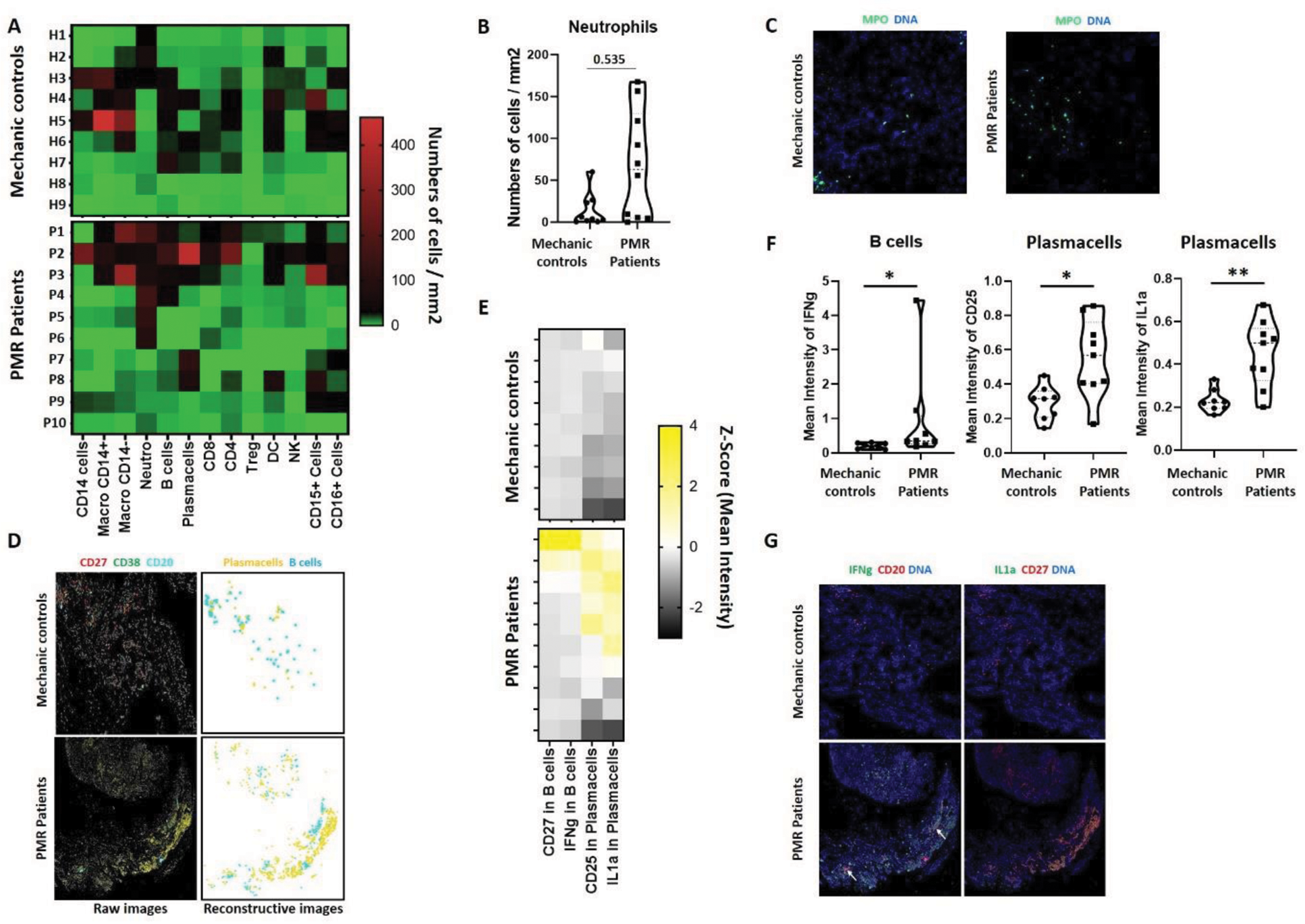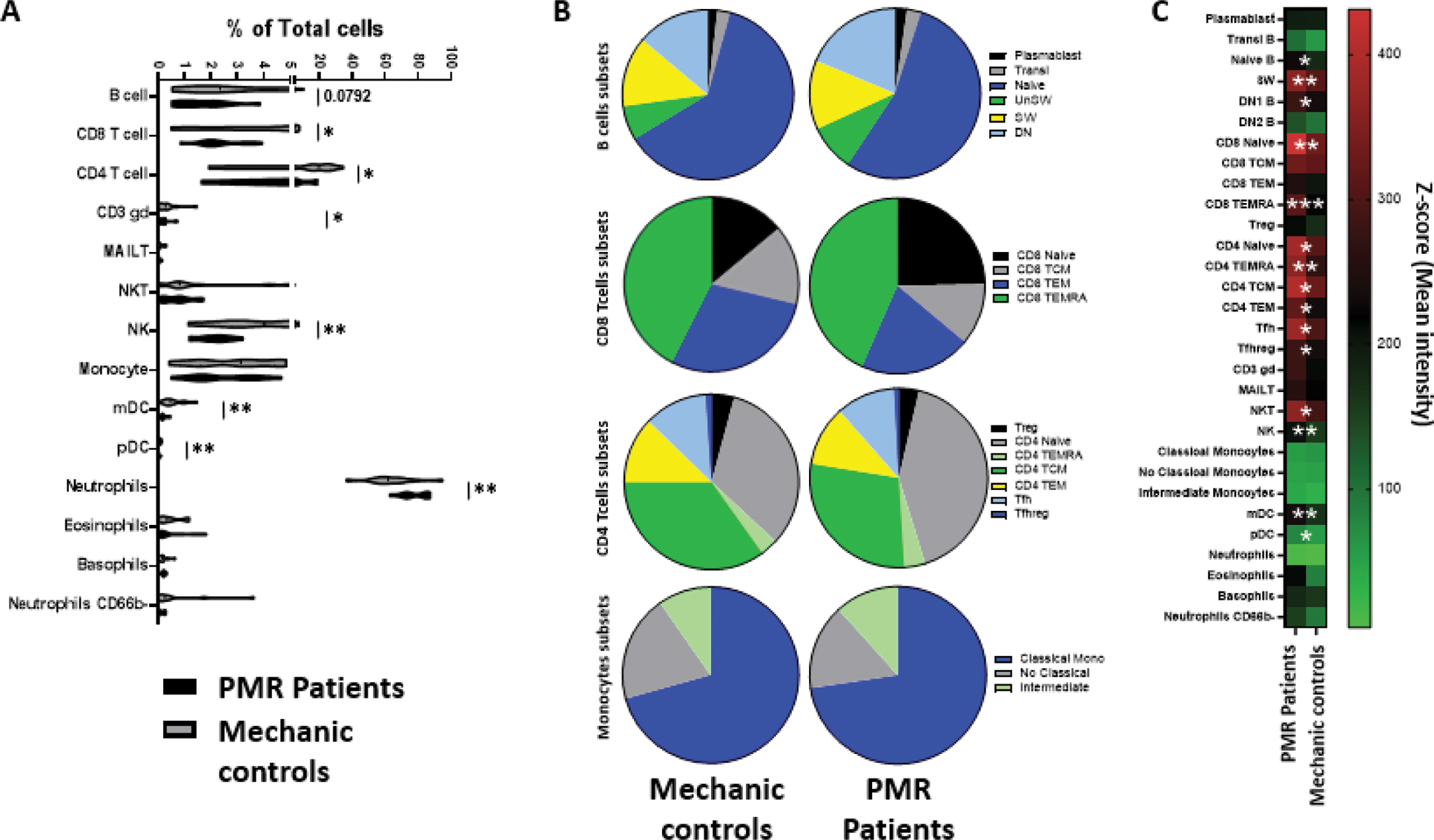

Background: The pathophysiology of polymyalgia rheumatica (PMR) remains poorly understood, with most studies focusing on blood analysis. However, findings in diseases like giant cell arteritis, Sjögren’s disease, and systemic lupus erythematosus suggest that blood observations may not fully reflect tissular processes. Over the past decade, only one study has investigated shoulder bursae in PMR, revealing cell infiltration and cytokine production.
Objectives: Our objectives were first to describe the infiltrate of immune cells in shoulder bursae of PMR patients with an active disease; second, to compare the infiltrate with controls affected by tendon injury or osteoarthritis; and last to compare findings in the bursae and in the blood of patients.
Methods: We conducted a prospective study analyzing bursa biopsies from PMR patients with active disease meeting the 2012 ACR/EULAR criteria. Ultrasound-guided, transcutaneous biopsy devices were used. Mechanic controls (MC)—patients undergoing shoulder surgery for osteoarthritis or rotator cuff injury—provided surgical waste tissue for comparison. Demographic data and C-reactive protein (CRP) levels were collected for PMR patients and MC. Blood samples were analyzed by flow mass cytometry (HELIOS), while tissue samples were analyzed by imaging mass cytometry (HYPERION). A commercial MAXPAR Direct Immune Profiling Assay was enhanced with anti-CD24, anti-CD11b, anti-IgM, anti-CD21, anti-CD95 (FAS), anti-Foxp3, and anti-Bcl2 antibodies. Statistical analysis were performed using GraphPad software. The study received approval from an ethics committee.
Results: Of 27 PMR patients screened, 11 met the 2012 ACR/EULAR criteria and had analyzable biopsies (median age 67.5, 5 women, 5 new-onset cases, median CRP 37 mg/L). Twelve MC were included (median age 73, 8 women, median CRP 3.5 mg/L). Synovial bursa biopsies from PMR patients revealed monocytes/macrophages, neutrophils, T cells and B cells (Figure 1A). PMR patients showed a trend toward higher neutrophil counts than MC (Figures 1B, C). While B and plasma cell counts were similar, PMR patients had more memory B cells (CD27+) expressing interferon-gamma and activated plasmacells producing IL-1 alpha (Figures 1E-G). Blood analysis showed reductions in CD3+ T cells, CD3+CD4+ T cells, CD3+CD8+ T cells, NK cells, myeloid dendritic cells, and plasmacytoid dendritic cells in PMR patients versus MC (Figure 2A). Although B cell counts trended lower, the difference was not significant. Most lymphocyte subsets in PMR patients exhibited higher Bcl-2 expression. Naïve B cells were predominant in blood, while activated memory B cells and plasmacells were increased in tissue compared to MC.
Conclusion: This study is the first to perform a comprehensive analysis of cell subsets in shoulder biopsies from PMR patients. We confirmed immune cell infiltration in the bursae of patients with active disease. B cells and plasmacells in PMR tissue showed increased activation and inflammatory cytokine production compared to MC. Discrepancies between blood and tissue findings highlight the need for further shoulder biopsy studies to enhance understanding of PMR pathophysiology.
REFERENCES: NIL.
Distribution of immune cells in the shoulder bursae of patients with active polymyalgia rheumatica (PMR) and in mechanic controls from the imaging mass cytometry analysis in tissue (HYPERION). A Heat map representing the density (number of cells per mm²) of immune cells in the different samples. B Number of neutrophils per mm² in PMR patients and mechanic controls. C Example of HYPERION analysis of neutrophils. D Example of Hyperion analysis of B cells and plasmacells. E-F Expression of CD27 and IFN gamma in B cells and CD25 and IL-1 alpha in plasmacells in PMR patients and mechanic controls G Example of HYPERION analysis of IFN gamma expressing B cells and IL-1a expressing plasmacells.

Distribution of immune cells in the blood of patients with active polymyalgia rheumatica (PMR) and in mechanic controls from the mass cytometry analysis in blood (HELIOS). A Percentage of each immune subset from the total in PMR patients and mechanic controls. B Distribution of B cell, CD8+ cells, CD4+ cells and monocytes subsets in PMR patients and mechanic controls. C Expression of Bcl2 in the different cell subset in PMR patients and mechanic controls.

Acknowledgements: NIL.
Disclosure of Interests: None declared.
© The Authors 2025. This abstract is an open access article published in Annals of Rheumatic Diseases under the CC BY-NC-ND license (